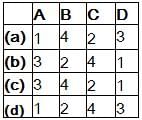Electrical Engineering (EE) Exam > Electrical Engineering (EE) Tests > Control Systems > Test: Introduction to Control Systems- 2 - Electrical Engineering (EE) MCQ
Test: Introduction to Control Systems- 2 - Electrical Engineering (EE) MCQ
Test Description
10 Questions MCQ Test Control Systems - Test: Introduction to Control Systems- 2
Test: Introduction to Control Systems- 2 for Electrical Engineering (EE) 2025 is part of Control Systems preparation. The Test: Introduction to Control Systems- 2 questions and answers have been
prepared according to the Electrical Engineering (EE) exam syllabus.The Test: Introduction to Control Systems- 2 MCQs are made for Electrical Engineering (EE) 2025 Exam. Find important
definitions, questions, notes, meanings, examples, exercises, MCQs and online tests for Test: Introduction to Control Systems- 2 below.
Solutions of Test: Introduction to Control Systems- 2 questions in English are available as part of our Control Systems for Electrical Engineering (EE) & Test: Introduction to Control Systems- 2 solutions in
Hindi for Control Systems course. Download more important topics, notes, lectures and mock
test series for Electrical Engineering (EE) Exam by signing up for free. Attempt Test: Introduction to Control Systems- 2 | 10 questions in 30 minutes | Mock test for Electrical Engineering (EE) preparation | Free important questions MCQ to study Control Systems for Electrical Engineering (EE) Exam | Download free PDF with solutions
Test: Introduction to Control Systems- 2 - Question 1
Match List- I (Laplace transforms) with List - II (Time functions) and select the correct answer using the codes aiven below the lists:

Codes:


Codes:

Detailed Solution for Test: Introduction to Control Systems- 2 - Question 1
Test: Introduction to Control Systems- 2 - Question 2
A standard signal used for comparison in a closed-loop control system is called the
Detailed Solution for Test: Introduction to Control Systems- 2 - Question 2
Test: Introduction to Control Systems- 2 - Question 3
The difference between the output response and the reference signal is known as the _____ signal.
Detailed Solution for Test: Introduction to Control Systems- 2 - Question 3
Test: Introduction to Control Systems- 2 - Question 4
The Laplace transform of unity function is
Detailed Solution for Test: Introduction to Control Systems- 2 - Question 4
Test: Introduction to Control Systems- 2 - Question 5
The phenomena of ‘limit cycles’ and ‘jump resonance’ are observed in
Detailed Solution for Test: Introduction to Control Systems- 2 - Question 5
Detailed Solution for Test: Introduction to Control Systems- 2 - Question 6
Test: Introduction to Control Systems- 2 - Question 7
A control system is said to be robust when
Detailed Solution for Test: Introduction to Control Systems- 2 - Question 7
Test: Introduction to Control Systems- 2 - Question 8
Which of the following is not correctly matched?
(CLCS = Closed Loop Control System and OLCS = Open Loop Control System)

Detailed Solution for Test: Introduction to Control Systems- 2 - Question 8
Test: Introduction to Control Systems- 2 - Question 9
Which of the following is not true regarding an open loop control system?
Detailed Solution for Test: Introduction to Control Systems- 2 - Question 9
Test: Introduction to Control Systems- 2 - Question 10
As compared to a closed loop system, an open loop system is
Detailed Solution for Test: Introduction to Control Systems- 2 - Question 10
|
54 videos|83 docs|40 tests
|
Information about Test: Introduction to Control Systems- 2 Page
In this test you can find the Exam questions for Test: Introduction to Control Systems- 2 solved & explained in the simplest way possible.
Besides giving Questions and answers for Test: Introduction to Control Systems- 2, EduRev gives you an ample number of Online tests for practice






















